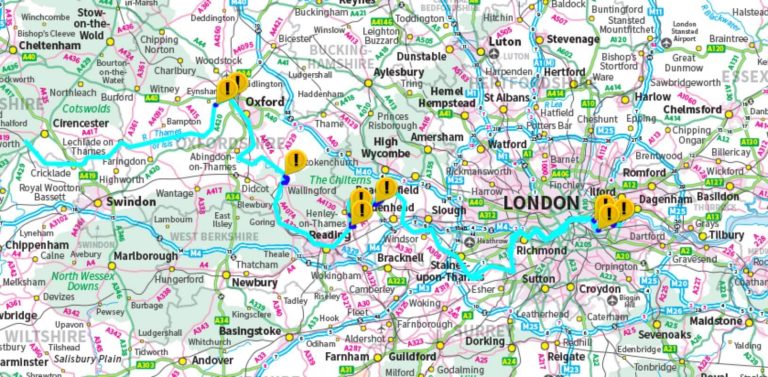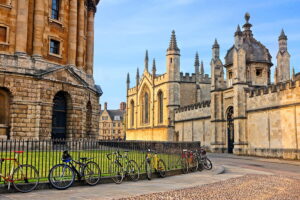
Walking The Thames Path – Planning Your Route
The Thames Path is a National Trail following the course of the longest river in England River Thames at 215 miles, from its source in the Cotswolds to the Thames Barrier in London. Walking the Thames Path is a popular activity for hikers, offering scenic views, historical landmarks, and a chance to experience the diverse landscapes along the river.
Many people choose to embark on the long journey because the Thames Path showcases a range of spectacular landscapes, including rural countryside, charming villages, bustling towns, and iconic cityscapes. Along the way, you’ll encounter famous landmarks such as the Cotswolds, the University of Oxford, Windsor Castle, Hampton Court Palace, and the Tower of London.
Planning your Thames Path Route
If you are planning to walk the Thames Path with a group of friends or family and require guidance and comprehensive information to ensure a seamless journey, this article provides all the necessary details. It covers a step-by-step guide on planning your route, walking the Thames path in stages and frequently asked questions.

Planning your route
Planning the Thames Path route requires careful consideration to ensure an enjoyable and well-organised journey.
Here’s a step-by-step guide on how to plan your Thames Path route:
- Decide how long you want to spend walking the Thames Path. This will help you divide the route into manageable sections or determine if you have enough time to complete the entire path in one go.
- Familiarise yourself with the Thames Path by studying maps, guidebooks, and online resources. Understand the starting point, endpoint, and key landmarks along the way. Consider any areas that might require detours or have limited access.
- Decide whether you want to walk the Thames Path from its source to the Thames Barrier or vice versa. Both directions have their merits, but it’s essential to consider factors such as prevailing winds, public transport connections, and personal preferences.
- Divide the Thames Path into stages based on your walking pace, available time, and desired daily distances. Determine the starting and ending points for each stage, keeping in mind accommodations, amenities, and transport options in those areas.
- Identify notable landmarks, attractions, and detours that you’d like to visit along the Thames Path. This could include historic sites, picturesque villages, or places of interest. Plan for additional time or side trips to explore these highlights.
- Research and book accommodations in advance, particularly if you’re walking during busy periods or in popular areas. Look for accommodations near the path or in nearby towns and villages. Consider a mix of hotels, guesthouses, campsites, or other suitable options.
- Evaluate transportation choices for reaching the starting point of each stage and returning from the endpoint. Utilize public transportation, such as trains, buses, or boats, and check schedules and connections accordingly.
- Stay informed about any path diversions, closures, or temporary restrictions. Check the official Thames Path website, local authority websites, or signage along the path for up-to-date information.
- Prepare a packing list based on the duration of your walk and the weather conditions. Include appropriate footwear, comfortable clothing, waterproofs, snacks, water, navigation tools (maps or GPS), a first aid kit, and a charged mobile phone.
- Keep in mind that plans may need to be adjusted along the way due to unforeseen circumstances or personal preferences. Stay open to spontaneous detours, alternate routes, or rest days to enhance your overall experience.
Remember to consult official resources, local authorities, and experienced walkers for additional guidance and recommendations while planning your Thames Path route. With thorough preparation, you can make the most of your journey and enjoy the beautiful landscapes and historical treasures along the River Thames.

Walking the Thames Path in stages
You can walk the Thames Path in stages. In fact, many people choose to break down the journey into smaller sections and complete it over multiple trips or weekends. Walking the Thames Path in stages allows you to customize the experience according to your available time, fitness level, and preferences.
Here are some tips for walking the Thames Path in stages:
Plan your stages
Look at the overall route of the Thames Path and divide it into manageable sections based on the distance you feel comfortable walking in a day. Consider factors such as available accommodations, public transportation options, and points of interest along each stage.
Accessibility and logistics
Make sure the starting and ending points of each stage are easily accessible by public transport or have nearby parking facilities if you’re driving. This will help you plan your logistics for reaching and departing from each section.
Thames Path Accommodation
Research and book accommodations in advance, especially if you’re walking during peak seasons or in popular areas. There are various options available, including hotels, bed and breakfasts, campsites, and guesthouses. Consider staying in towns or villages near the path for convenience.
Our welcoming hotel Milton Hill is just off the Thames Path trail, located in Abingdon, Oxford offering comfortable rooms in a stunning manor house venue.
Additionally, there are also pubs, cafes, and shops along the route to replenish supplies or take a break.
Transport
Determine the best way to reach the starting point of each stage and return from the endpoint. Public transportation, such as trains, buses, or boats, can often be used to access different sections of the Thames Path. Check schedules and connections in advance to avoid any surprises.
Breaks and rest days
It’s important to listen to your body and take breaks as needed. Consider incorporating rest days into your itinerary, especially if you’re walking multiple stages consecutively. This will give you time to relax, explore nearby attractions, or simply enjoy the surroundings.
Navigation and resources
Carry detailed maps, guidebooks, or digital navigation tools to help you navigate the path during each stage. These resources will provide information about the route, landmarks, amenities, and alternative paths in case of diversions or closures.
Enjoy the journey
Take your time to soak in the scenery, discover local attractions, and interact with the communities along the way. The Thames Path offers a rich tapestry of natural beauty, history, and culture, so make the most of your stages by exploring the surroundings.
What to take on your big walking adventure
Remember to pack essential items such as comfortable walking gear, weather-appropriate clothing, snacks, water, a first aid kit, and a fully charged mobile phone. Stay updated on any path diversions, closures, or safety information by checking the official Thames Path website or local authorities before setting off on each stage.
Walking the Thames Path in stages allows you to savour the experience at your own pace and fully appreciate the diverse landscapes and landmarks along the river.
Other things to consider on your journey
Accessibility
The Thames Path is generally accessible to walkers of all abilities. It features a combination of riverside paths, meadows, fields, country lanes, and urban sections. However, it’s important to note that certain stretches might be uneven or muddy, so appropriate footwear is recommended.
Thames Path Passport:
The Thames Path Team and Walk the Thames have joined forces to introduce an exciting initiative called the Thames Passport. This initiative allows you to commemorate your accomplishment of walking the Thames Path by collecting stamps in a dedicated Thames Path Passport.
As you progress along the path, you can obtain a stamp on each page, and upon completing the collection, you will receive a certificate acknowledging your achievement. It’s a wonderful way to formalize your journey and create lasting memories of your Thames Path experience.
Are you interested in contributing towards the upkeep of the trail? Find out more information on the passport scheme on the Walk the Thames website.
Walking the Thames Path FAQs
Here are some FAQs about walking the Thames Path:
How long does it take to walk the Thames Path?
The entire Thames Path is approximately 184 miles (294 kilometres) long. It can be completed in sections or as a continuous hike, depending on your preference and available time, it takes a couple of weeks for most hikers.
Where is the Thames Path starting point?
The trail begins at Thames Head near Kemble in Gloucestershire and passes through several counties, including Oxfordshire, Berkshire, Buckinghamshire, Surrey, and Greater London, before reaching the Thames Barrier at Charlton. The path is well-signposted and relatively easy to follow.

When is the Best Time to Go?
The Thames Path can be enjoyed year-round, but the most popular time to walk it is during spring and summer when the weather is generally mild. The path can get busy, especially in popular areas, during weekends and holidays. Consider weekdays or shoulder seasons for a quieter experience.
Before embarking on your Thames Path journey, it’s recommended to plan your route in advance, check for any path diversions or closures, and ensure you have appropriate maps or guidebooks. You should also pack essentials such as comfortable walking gear, snacks, water, a first aid kit, and a fully charged mobile phone for emergencies.
For more information and FAQs please see the official Thames Path website which provides details about the most common questions on the Trail.
Conclusion
We trust that you found our article informative, providing you with important insights on walking the Thames Path. We covered planning your route, guidance on walking the path in stages, details about accommodation options, frequently asked questions, and general information about the experience.
May your walk along the Thames Path be truly delightful as you immerse yourself in the captivating beauty and rich history that the river and its surroundings have to offer. Embrace every moment of your journey!
Go back to other articles

